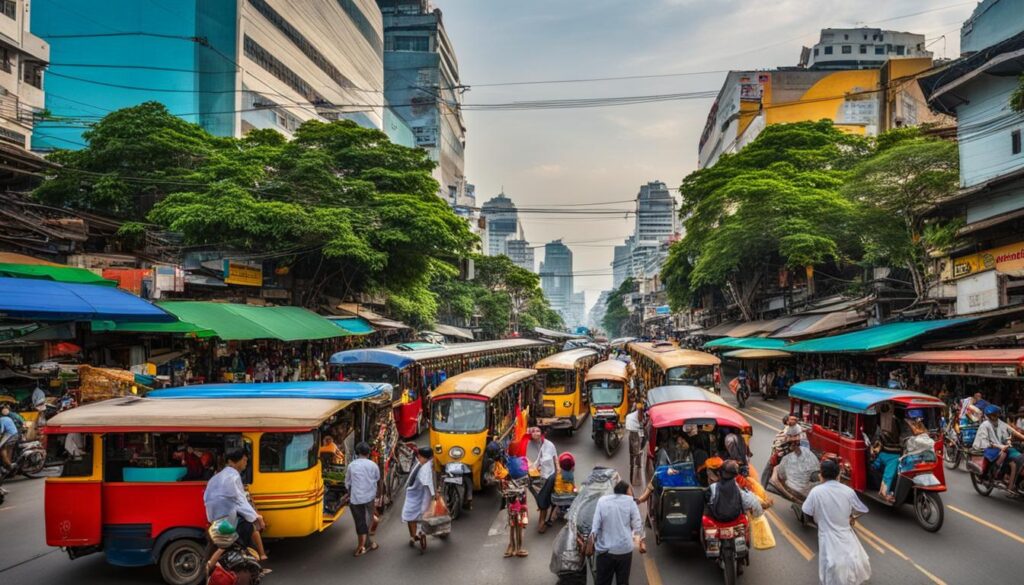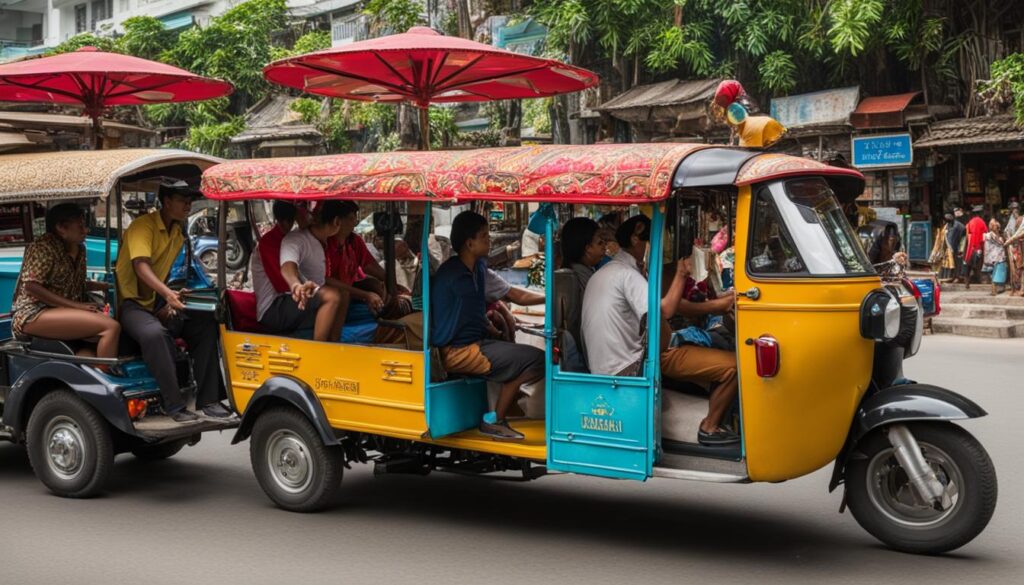Are you planning a trip to Bangkok but concerned about the language barrier? Don’t worry, you’re not alone. Navigating a foreign country where you don’t speak the language can be daunting, but it doesn’t have to be. In this comprehensive guide, we’ll provide you with tips and advice on how to get around Bangkok without speaking Thai.
Whether you’re a tourist or an expat, getting around Bangkok without knowing Thai is entirely possible. From utilizing public transportation to hiring a local guide, there are many options available to make your experience in Bangkok smooth and enjoyable.
Join us as we explore various strategies, including the transportation options available, using translation apps and phrasebooks, employing non-verbal communication techniques, and so much more. With these resources at your disposal, you’ll find that navigating Bangkok without speaking Thai is easier than you ever thought.
Understanding Transportation Options in Bangkok
As a non-Thai speaker, navigating Bangkok may seem daunting, but there are various transportation options available to you. Knowing what transportation options are available will help you get around the city with ease, even without speaking Thai. Here are some transportation options for English speakers in Bangkok:
BTS Skytrain and MRT Subway
The BTS Skytrain and MRT Subway are the most convenient and accessible options for getting around Bangkok. Both systems have clear signage in English and offer single-journey tickets and day passes, making it easy to navigate without having to communicate in Thai. The BTS covers areas in central Bangkok, while the MRT serves inner suburbs.
Buses
Buses are a cheap and efficient way to get around Bangkok, but the bus system can be quite complex for non-Thai speakers. However, there are bus route maps available in English at bus terminals and kiosks. It’s best to plan your route in advance, and make sure you have the name of your destination written in Thai to show the driver or other passengers if you need help.
Taxis and Ridesharing Services
Taxis and ridesharing services like Grab are widely available in Bangkok, but communicating with drivers can be challenging if you don’t speak Thai. It’s best to have your destination written in Thai or show the driver on a map. If you use Grab, the app has a translation feature that can help you communicate with the driver.
Motorcycle Taxis
Motorcycle taxis are a fast and convenient way to get around Bangkok, especially during peak traffic hours. It’s important to wear a helmet, which is offered by the driver, and negotiate the price before getting on. As a non-Thai speaker, it’s best to have your destination written in Thai.
Tuk-tuks
Tuk-tuks are a fun and iconic mode of transportation in Bangkok, but they can be expensive compared to other options. As a non-Thai speaker, it’s best to negotiate the price upfront and have your destination written in Thai.
Boats
Bangkok’s Chao Phraya River is a great way to see the city’s landmarks and avoid traffic. Boats run between the various piers along the river, and most tourist attractions have piers nearby. The boat operators may not speak English, but there are maps available in English to help you navigate the different routes.
By understanding the transportation options available, you can travel around Bangkok without the need for speaking Thai. Whether you choose to take the BTS Skytrain, ride a motorcycle taxi, or hop aboard a boat, getting around Bangkok is accessible and convenient for non-Thai speakers.
Utilizing Public Transportation in Bangkok
One of the best ways to get around Bangkok without language barriers is by utilizing the city’s extensive public transportation system. The BTS Skytrain, MRT subway, and buses are all great options for non-Thai speakers.
The BTS Skytrain is an elevated train that runs through the city, covering many of Bangkok’s major tourist destinations. Signs and announcements are in both Thai and English, making it easy to navigate. You can purchase a single ride ticket or a day pass, which will give you unlimited rides for the day.
The MRT subway is an underground train system that also covers many areas of the city. Signs and announcements are in both Thai and English, and you can purchase single ride tickets or a stored value card, which you can refill as needed.
| Transportation Option | Pros | Cons |
|---|---|---|
| BTS Skytrain | Easy to navigate, covers major tourist destinations, signs and announcements in English | Can be crowded during peak hours |
| MRT subway | Covers many areas of the city, signs and announcements in English | Can be crowded during peak hours |
| Buses | Covers many areas of the city, affordable | Can be confusing to navigate, signs and announcements in Thai |
Buses are another option for non-Thai speakers, but they can be a bit more challenging to navigate. Signs and announcements are typically in Thai, so it’s best to ask the driver or conductor for assistance. Buses are also a more affordable option, with fares starting at just 8 baht.
By utilizing public transportation in Bangkok, you can save money on transportation costs and avoid the stress of navigating the city’s busy streets. Just be sure to keep an eye on your belongings and be aware of your surroundings, especially during peak hours when trains and buses can get crowded.
Taxis and Ridesharing Services in Bangkok
Despite the language barrier, taking a taxi or ridesharing service like Grab can be a convenient way to get around Bangkok. These services allow you to request a ride from your phone and pay through the app, eliminating the need for communicating with the driver in Thai.
Before getting into a taxi, it’s essential to have the destination in written form, either on your phone or on a piece of paper. This way, you can show the driver where you need to go without relying on verbal communication.
It’s also helpful to have a translation app on hand, such as Google Translate, to communicate with the driver if needed. You can type in your destination in English and have the app translate it into Thai for the driver to read.
When using ridesharing services like Grab, make sure to confirm the destination with the driver before the ride starts. You can use the app’s messaging function to communicate with the driver and ensure they understand where you want to go.
It’s worth noting that some drivers may still struggle with English, and even with translation apps, miscommunications can happen. To avoid this, it’s helpful to have a basic understanding of Thai numbers and directions to communicate important details like addresses and landmarks.
Pro Tip: Tipping is not expected in Bangkok, but rounding up to the nearest multiple of 10 baht is common practice.
Exploring Bangkok on Foot
Walking is a fantastic way to explore Bangkok and immerse yourself in its vibrant culture. You don’t need to speak Thai to enjoy a leisurely stroll through the city’s bustling streets and discover hidden gems. To make the most of your walking tour, here are some tips to explore Bangkok without language barriers:
- Use a map or GPS to navigate your route. Many smartphone apps, such as Google Maps, can provide step-by-step directions.
- Look for landmarks to guide you along the way, such as the iconic Wat Arun or the busy Chatuchak Market.
- Observe the locals and how they interact with their surroundings. You may pick up on social cues and customs that will enhance your experience.
- Engage in non-verbal communication techniques, such as pointing or gesturing, to ask for directions or communicate with locals.
- Wear comfortable clothing and shoes, as Bangkok can get hot and humid. Be prepared for sudden rain showers with a small umbrella or rain poncho.
Exploring Bangkok on foot allows you to take in the city’s vibrant atmosphere and discover hidden gems that you wouldn’t otherwise see. From colorful street art to quaint local shops, walking in Bangkok is an adventure that you won’t want to miss. So put on your walking shoes and get ready to explore!
Hiring a Local Guide or Joining Group Tours
If you prefer a more structured experience while exploring Bangkok, hiring a local guide or joining group tours is an excellent option. Not only will you be able to navigate the city without language barriers, but you’ll also gain invaluable insight into Bangkok’s culture and history.
Local guides are an especially great option if you’re interested in exploring specific neighborhoods or attractions. They can help you understand the significance of each location and provide context that you wouldn’t be able to discern on your own.
Similarly, group tours can be an excellent way to meet fellow travelers and learn from experienced guides. Many tours offer transportation and admission to popular attractions, making it an ideal option for those looking for a hassle-free experience.
When choosing a guide or tour, make sure to research the company beforehand and read reviews from past customers. This will give you a better idea of their experience and reliability.
Keep in mind that hiring a guide or joining a tour can be more expensive than other transportation options, so it’s important to budget accordingly. However, the benefits of having a knowledgeable local guide can make it well worth the cost.
Utilizing Translation Apps and Phrasebooks
If you’re traveling to Bangkok without knowing Thai, it can be challenging to communicate with locals. However, with the help of translation apps and phrasebooks, you can bridge the language gap and enjoy your travels with confidence.
Translation apps like Google Translate and iTranslate can instantly translate Thai text into English and vice versa. In addition to text translations, some apps also offer voice translations, which can be helpful when communicating verbally with locals.
Phrasebooks are also a useful resource for learning essential Thai phrases for everyday situations, such as ordering food, asking for directions, or haggling at markets. These pocket-sized books contain simple phrases with English translations, making it easier for you to communicate with locals.
It’s important to note that not all translation apps and phrasebooks are created equal. Some apps may offer more accurate translations, while others may have more extensive language databases. Do your research beforehand and read reviews to ensure you’re downloading a reliable app or purchasing a reputable phrasebook.
While translation apps and phrasebooks can be incredibly useful, it’s essential to keep in mind that they’re not foolproof. Translations may not always be completely accurate, and some phrases may have different meanings depending on the context. Additionally, relying too heavily on technology can hinder your ability to learn and immerse yourself in the local culture.
Use translation apps and phrasebooks as a backup plan when necessary, but also try to learn a few basic phrases in Thai. Locals will appreciate the effort, and it can often lead to more meaningful interactions.
Engaging in Non-Verbal Communication Techniques
When language fails, non-verbal communication can come to the rescue. While Thai is the official language, many locals in Bangkok speak English and can understand basic words and phrases. But, in cases when language falls short, non-verbal communication techniques can be incredibly effective. The following tips will help you navigate Bangkok without knowing Thai:
- Use visual aids: Maps, diagrams, and illustrations can help you communicate your needs and requests without speaking.
- Gesture: Gestures and facial expressions can convey emotions and needs. Use hand signals, thumbs up/down, and nodding to communicate effectively.
- Pay attention to body language: Observe the body language of the person you’re communicating with and mimic it to build rapport and understanding.
- Be patient: Don’t get frustrated if communication fails. Stay calm, smile, and try again.
Remember, non-verbal communication is a two-way street. You should also be observant of the non-verbal cues of the person you’re communicating with. By using these techniques, you can navigate the city with ease, even if you don’t speak Thai.
Conclusion
In this comprehensive guide, you have explored various strategies to help you get around Bangkok without speaking Thai. By utilizing public transportation, taxis, walking, hiring guides, using translation apps, and employing non-verbal communication techniques, you can navigate the city effortlessly and make the most of your time in Bangkok.
Plan Your Next Language Barrier-Free Adventure
With these tips and resources at your disposal, you can explore the vibrant city of Bangkok with confidence, regardless of your language skills. But why stop there? Apply these same techniques to other destinations and enjoy a barrier-free travel experience. Remember to always be aware of your surroundings and take necessary precautions to stay safe.
Stay Adventurous
Don’t let a language barrier prevent you from experiencing the world. With a little preparation and resourcefulness, you can confidently explore new destinations and create unforgettable memories. So pack your bags, plan your itinerary, and embark on your next adventure with confidence. The world is waiting for you.
















































